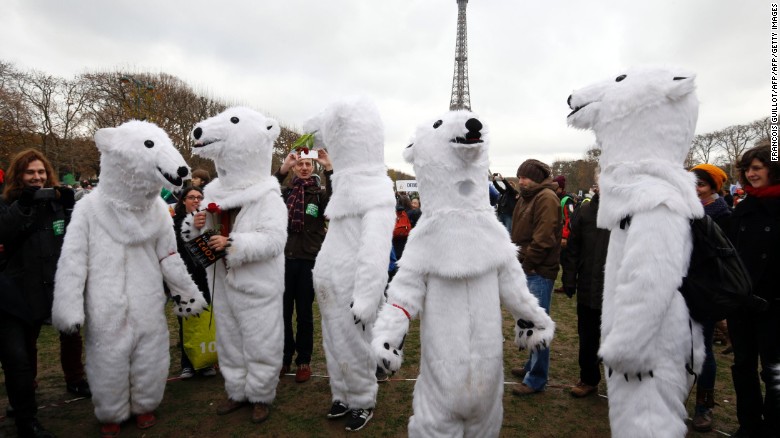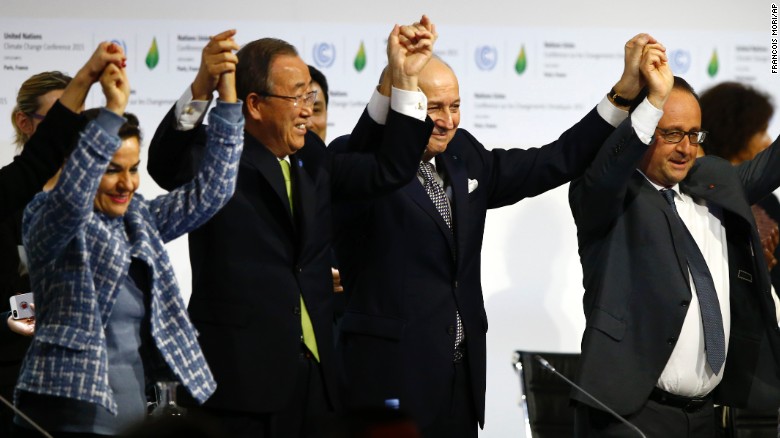
Demonstrators dress up as polar bears to take part in a climate rally Saturday in Paris.
“The end of the era of fossil fuels.”
“A victory for all of the planet and future generations.”
“A turning point for the world.”
It’s hard to overstate the importance of what happened in Paris over the weekend: Ministers from 195 countries adopted by consensus a legally binding agreement to fight climate change. The Paris agreement aims to help the world abandon fossil fuels this century and, specifically, stop global warming “well below” 2 degrees Celsius and, if possible, below 1.5 degrees.
Incredible, huh?
This is truly a remarkable moment, especially since it occurred during what likely will be the hottest year on record, and was adopted with global consensus and in Paris, the site of terror attacks almost exactly one month ago.
The accord, which came out of the COP21 meeting of the U.N. Framework Convention on Climate Change, has been years, if not decades, in the making. It’s a bold signal to boardrooms and national capitals around the world: The era of fossil fuels is over, and we’re moving toward cleaner (and safer and healthier) sources of energy fast.
On Saturday, I was in Le Bourget, France, the site of the two-week negotiations, when the decision came in. People were screaming and hugging and banging on desks — swapping espresso for beer. Politicians linked hands and swung them into the air, looking more like ecstatic cheerleaders than smart-suited diplomats. For many policy experts, this is the culmination of a life’s work on climate change. So many other attempts at treaties like this have failed.
That’s worth celebrating.
But no one is naive enough to think this treaty alone will “fix” climate change.
On this point, even the text adopted in Paris is self-aware, noting the “significant gap” between countries’ pledges and the goal of stopping warming short of 2 degrees. According to the UNFCCC’s own analysis, the pollution-reduction pledges made by countries ahead of the Paris talks would allow the atmosphere to warm 2.7 degrees Celsius by 2100.
That’s well beyond the 2-degree goal.
It also would be catastrophic for the planet and for people, wiping low-lying islands off the map as seas continue to rise; pushing many plants and animals toward extinction; increasing the intensity of droughts, floods, heat waves and storms; and costing all of us a lot of money.
The Paris agreement, then, would be most accurately described as a giant shove in the right direction. Nearly 200 countries agreed to a legally binding framework that commits them to upping their ambitions every five years, financing the transition to clean energy and continuing on this path. It doesn’t bind countries, however, to meet their climate targets, and it also doesn’t prescribe exactly how they should get there. There are no sanctions, for example, if China fails to meet its goal of peaking emissions by 2030 (there’s evidence it actually will do even better than that, at least partly because air pollution has become an economic and public health crisis) or if the United States breaks its promise of reducing greenhouse gas emissions 26% to 28% below 2005 levels by 2025.
The countries will be legally accountable to each other.
But they must take bold action as individuals, too.
Here are five actions that must follow the celebrations:
Contents
1. Ratify the Paris agreement

For the agreement to have legal force, it must be ratified by at least 55 of the 195 countries that adopted it without objection Saturday. Those 55 countries must represent at least 55% of all global-warming emissions. This is seen by many observers, including me, as a formality. There was broad consensus in support of this agreement and the message it sends about climate change. The Obama administration also argues the agreement can be ratified by an executive action, meaning it won’t have to go before the U.S. Senate, where many members of the GOP majority are skeptics of climate science and resist action.
That argument should hold, said Dan Bodansky of the Center for Law and Global Affairs at Arizona State University who has followed climate negotiations for decades. “It seems like this is the kind of agreement the president can join on his own,” he said.
The United Nations hopes to hold a formal signing ceremony in New York as soon as April.
2. End fossil fuel subsidies
Many of the 195 countries that adopted the Paris agreement actively are pumping money into dirty-energy industries when they’re not standing in the international spotlight.
Dropping those subsidies is something these countries can and should do immediately. Doing so would be a massive help as countries try to figure out how to limit carbon pollution.
If 20 major countries abandoned their subsidies, global carbon dioxide emissions in those countries would decline nearly 11% by 2020, compared with a business-as-usual scenario, according to a recent report from the International Institute for Sustainable Development and the Nordic Council of Ministers. If 30% of those funds were reinvested in clean energy, then emissions could be dropped 18% in the countries studied.
Laura Merrill, a senior researcher who worked on the report, told me global emissions likely would drop at least 10% if all fossil fuels subsides were cut. “I think it is the elephant in the boardroom, really,” she said. “It’s about $500 billion (in subsidies) downstream to consumers and about $100 billion (in subsidies) upstream to producers. That’s a huge amount of financing” that could be used for renewable energy.
It’s ironic at best that these massive subsidies continue in the United States, China, Saudi Arabia, Russia, the United Arab Emirates and elsewhere while leaders pledge commitment to a climate accord.
With oil and coal prices low, now is the right time to act.
3. Put a global tax on carbon pollution
Mention the word “tax” in just about any context in the United States, and you’re bound to see people squirm. But a broad coalition of business-savvy groups, including the World Bank, Unileverand Exxon Mobil, argue that some form of a carbon tax or pricing system should be used to account for the costs of fossil fuel pollution.
The reason is simple: Someone has to pay for the costs of carbon pollution, which include rising seas (threatening trillions in shoreline assets), more-intense droughts, air-pollution deaths and so on. The polluter should pay those costs, not the people and places affected by an unnatural increase in global surface and ocean temperatures. Plus, money from a carbon tax could be put into investments in clean energy and technology.
About 40 countries and more than 20 cities and states have implemented some form of a carbon-pricing system, according to a 2014 report from the World Bank. China is planning a national cap-and-trade system and already has tested the concept in several pilot regions. The United States and others need to consider these policies soon. Once the rationale for this kind of tax becomes more accepted, it should be tried globally.
4. Work toward political consensus
One of the most significant things about the Paris agreement is its symbolism: Nearly 200 countries agree we must take sweeping actions to address the climate crisis.
That type of consensus needs to emerge within those nations as well.
It clearly doesn’t exist yet. Over the weekend, U.S. Senate Majority Leader Mitch McConnell reportedly said the Paris agreement could be “shredded in 13 months” if a Republican is elected to the White House. Most of the leading Republican candidates for the U.S. presidency are climate skeptics, and most of the GOP candidates flunk climate science, according to a group of scientists The Associated Press assembled to analyze their public statements on this topic. (Jeb Bush did the best of the Republicans, but he only scored 64 of 100; the Democrats scored between 87 and 94 in terms of their accuracy.)
Pointing fingers won’t do any good. Somehow, we need to remove political divisions from this issue and come together to work for solutions. On my way to the U.N. talks in Paris, I stopped in Denmark, which has arguably the best climate policy in the world. No place is perfect, but there’s general agreement among all parties in Denmark that greenhouse gas pollution must be reduced and that the government should help encourage that transition. The country already is powered 40% by electricity from wind, and aims to be carbon neutral by 2050.
We have to move past the silly fights about science — the science is clear that we’re causing global warming and, in many ways, it’s worse than we thought — and focus on solutions.
5. Invest in greener technologies
The 1.5-degree target will essentially be impossible to achieve unless we develop new technologies to pull carbon out of the atmosphere. The World Bank estimates, for instance, that we’re headed for 1.5 degrees of warming based only on existing pollution.
We already have many, many technologies — from wind to solar and geothermal — that can help with the transition. Cutting back on the energy we use matters, too.
But given the scale of the transition required, it also is crucial that we listen to Bill Gates and other technologists who say we must make big bets on new clean-energy technologies.
There are signs that’s already happening. Gates was here in Le Bourget to announce an investment group that will put billions into clean-energy research.
The Paris agreement is truly a watershed moment in the world’s fight against climate change. It creates a legally binding framework for progress, and that’s fundamentally new.
But grand ambitions also must be met with concrete action.
[Source:- CNN]
